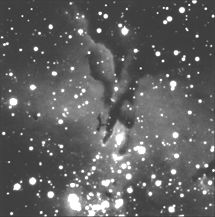SBIG Index
![]() News
News ![]() Products
Products ![]() Pricing
Pricing ![]() Distribution
Distribution ![]() Notes & Interesting Articles
Notes & Interesting Articles

Santa Barbara Instruments Group: The Pioneering CCD Company
 |
Above: Comet Hale-Bopp taken with Pentax 6 x 7 camera, 300 mm f/4 lens, piggyback on a Celestron C-8 telescope equipped with ST-4 autoguider. Michael Barber / SBIG
In most high technology markets there are "pioneers", companies who have the technology and dedication to influence the direction of an entire industry. In the past 10 years SBIG has been that pioneer in the electronic imaging industry. The "Santa Barbara Instruments Group" is a small company located in beautiful Santa Barbara, California. SBIG as it is more commonly known, has earned a distinct reputation among the international astronomical community of providing the proven best value and performance Charge Coupled Device (CCD) imaging and guide systems in their respective performance class.
The introduction of Charge-Coupled Devices (CCDs) has dramatically changed the methods astronomers use to view objects. The remarkable sensitivity and dynamic range of CCDs has made them the detector of choice. Unlike film, a CCD is an array of photosites (pixels) on a silicon substrate. The pixels are arranged in rows and columns. Light falling on the CCD is recorded as an electrical signal by converting the photons to electrons. The sensitivity of a CCD is at least ten times faster than the fastest films and are linear in response (which films are not). The number of photons converted to electrons, referred to as Quantum Efficiency, is in the order of 50%. These advantages as well as the digital nature of the data make CCD devices ideal for astronomical imaging. There are probably more SBIG CCD systems in use on astronomical telescopes than those of any competitor. But words such as innovative, practical and proven only gloss over the substance of SBIG.
Company Seven and SBIG Some years ago, Tony Hallas (yes THAT Tony Hallas) and the fearless leader of Company Seven (Martin Cohen) discussed several astrophotographs taken by Tony and his wife Daphne using an Astro-Physics telescope. Tony advised that those photos were taken with the aid of a CCD automatic guiding system controlling his equatorial mount. Furthermore, this system (the SBIG Model ST-4) could also be employed with a computer for use as a very sensitive imaging camera! At first glance Martin was skeptical since over the years many companies had offered or promised to offer guide systems of various operating principles, but up to that time none had actually ever delivered on that promise. But Martin does not discount the opinion of those who have proved themselves as Tony Hallas and Daphne Mount had. After further evaluation of an ST-4, it was realized that this was truly the first autoguider that worked! It was so miraculous a revelation to us at Company Seven - to finally find a system that renders sitting at a guiding eyepiece while making fine adjustments to telescope tracking over the course of a frigid evening obsolete was of great importance. And an imaging system selling for under $1,000 seemed a bit hard to believe.
Martin contacted Mr. Richard Schwartz, President and cofounder of SBIG to discuss the possibility of Company Seven offering these systems for resale to our customers. At the time SBIG had no distributors. However, we were insistent that we had to offer these systems to our customers even if we had to buy them at retail price from SBIG: our shop has as its foundation a mission to support ourselves (and secondly - our customers) with good products in any manner possible regardless of the profit margin. After some thought, SBIG agreed to permit Company Seven to offer their systems as their first authorized distributor.
Reviews published of SBIG systems feature consistently high praise for excellence and innovation. A "Sky and Telescope" magazine review of the SBIG ST-6 system concluded that for those who were waiting for CCD technology to evolve to the point that the cost and performance were equitable "CCD imaging has arrived". The ST-4 can be found in use as a guider on many respected amateur astronomers telescopes, and at professional observatories including the Mount Palomar 48" Schmidt Camera photo guide telescope! The ST-6 and its variants set a new standard in imaging with features such as "Track and Accumulate" (TRACCUM), and by the introduction of tricolor imaging. And the ST-7 and ST-8 each with an integral autoguide chip in parallel to the imaging chip. With newer technology detectors and their edge in research and development, the SBIG systems remain the technological standard against which others are measured into the 21st century.
 |
M16 Nebulous Star Cluster.
300 |
While SBIG has become highly regarded for their many patented innovations, a measure of their worth is how the customer is treated with respect and dignity. The products by SBIG do what they are advertised to do, and often surpassing the customers expectations. The people at SBIG are experienced users of the equipment who care about their customers long term success. Those companies and individuals that have dealt with SBIG understand what we are talking about here, and this is reflected by the many companies and users that wholeheartedly endorse (with no renumeration or other bribe), support and even offer third party options for SBIG systems, in some cases while refusing to support products of others. So, when you do decide to purchase a CCD system - look at how trusted the manufacturer is by their clientele, and at the quality of their vendor.
Contents Copyright 1994-2004 Company Seven - All Rights Reserved

